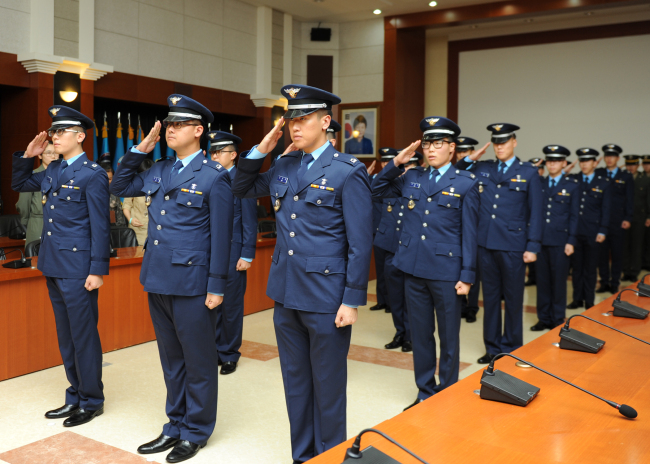While the translation of different languages is one of the most commonly known forms of interpretation, there are other unique types of interpretation that serve to protect the people or connect societies that otherwise remain poles apart.
 |
| Air Force interpreter officers salute at a ceremony in March at the Air Force’s Operations Command in Osan Air Base, Gyeonggi Province, marking their completion of training. Air Force Air Force interpreter officers salute at a ceremony in March at the Air Force’s Operations Command in Osan Air Base, Gyeonggi Province, marking their completion of training. Air Force Air Force interpreter officers salute at a ceremony in March at the Air Force’s Operations Command in Osan Air Base, Gyeonggi Province, marking their completion of training. Air Force Air Force interpreter officers salute at a ceremony in March at the Air Force’s Operations Command in Osan Air Base, Gyeonggi Province, marking their completion of training. Air Force Air Force interpreter officers salute at a ceremony in March at the Air Force’s Operations Command in Osan Air Base, Gyeonggi Province, marking their completion of training. Air Force |
They range from sign language translators who act as the gateway to the outside world for the deaf, to soldiers missioned with a crucial role to deliver military information in the world’s last-remaining divided country.
In Korea, there are about 1,200 sign language translators. Their job goes beyond translating words into signs to also providing necessary administrative information and help outdoor activities for the deaf whose population here has reached 270,000 last year.
Of them, around 500 interpreters hold expertise in translating the gestures of the deaf into proper sign language for those who could not learn the cheirology at an early age.
Once certified as sign language translators, they are dispatched to various workplaces ranging from hospitals, courts and broadcasting stations to banks. In the case of courts, the interpreters are assigned per case instead of an individual involved in a lawsuit for privacy reasons. The job of a sign language interpreter requires state-authorized certificates which takes about three to four years to achieve on average.
The most important factor of sign language interpretation is not the hands but the facial expression.
“The sign language cannot be delivered without facial expression. In vocal languages, people without hearing problems can express the degree of pain or different nuances with the tone of voice. That is what the facial expression does in sign language,” said sign language translator Kwon Na-yeon at Seoul Korean Sign Language Professional Institute. She added that the different grammar order of Korean vocal language and the sign language remains a challenge despite her seven years of experience that calls for continuous training.
Woo Jee-hee, 36, who works at a public sign language interpretation center in Seoul, said sign language translation inevitably takes more time.
“This is about visualizing the vocal language. It takes usually 1.2 times longer to interpret simultaneously.”
Meanwhile, interpretation in the military is also one of the rare fields that requires specialized skills with their work dealing with some of the most security-sensitive and confidential information.
On the divided peninsula, military cooperation with the U.S. and other countries remains crucial, and interpreter officers are dispatched to joint military drills and high-level talks.
Interpreter officers are picked through a set of exams that include written and verbal tests. Once enrolled, they go through military training and translation education before being designated to posts. There are those assigned to the fields of combined operations with the U.S. troops such as the Combined Forces Command, to those dispatched to the Defense Ministry, Joint Chiefs of Staff and other affiliated organizations that also deal with military cooperation with other countries.
The unusual position entails professional terms and concepts that require quick learning and nonstop research. For smooth and accurate interpretation, interpreter officers stress that a strong mentality is essential.
“I think the most important traits are mental agility and guts. It’s a highly technical job for which there are little to no scripted events. You need to be able to learn quickly and control yourself not to get intimidated or frozen, even when you’re interpreting matters of great sensitivity with some of the most important decision makers in the world,” said ex-Air Force interpreter officer Cho Koon-ho. He was once in charge of interpreting the live news conference over the probe result of the torpedo attack on the corvette Cheonan in March 2010.
He was directed to interpret the conference just hours before the event, and with little familiarity of the naval and nautical jargon, he crammed a hefty amount of professional information.
“The good thing about this job is that you are able to deploy a valued skill-set that makes a meaningful, visible positive impact. I was grateful to contribute in some small way to the resolution of that terrible tragedy,” he added.
By Lee Hyun-jeong (rene@heraldcorp.com)

